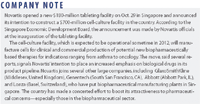News
Article
Pharmaceutical Technology
In the Field
Author(s):
Congress Focuses on FDA Inspections of Foreign Drug Facilities; Medical Students Oppose Big Pharma's Influence on Campus; FDA Revises Postmarketing Reporting Requirements
INTERNATIONAL
Congress Focuses on FDA Inspections of Foreign Drug Facilities
The US Food and Drug Administration's effectiveness in regulating the manufacture of pharmaceutical products and active pharmaceutical ingredients (APIs) at foreign facilities was questioned at a Congressional hearing in early November. Congress, industry, and government officials weighed in on the issue.

"Most Americans do not realize that today many of the drug products in their medicine cabinets come from overseas," said Rep. Bart Stupak (D-MI), chairman of the Subcommittee on Oversight and Investigations in a prepared statement. The subcommittee held a hearing about FDA Commissioner Testifies Before Congress on Foreign Inspection Process foreign-inspection process that was intended to evaluate the agency's effectiveness in overseeing foreign drug production. The hearing also explored what resources the agency realistically needs to do the job.
Stupak said that more than 80% of the APIs that go into drugs come from abroad, and that India and China account for almost half of those imports. "India's pharmaceutical imports into this country have increased 2400% from 1996 to 2006, making it the fastest-growing drug importer, and China has doubled its pharmaceutical exports to the US over the last five years," he added.
Federal law requires follow-up inspections for US drug manufacturers every two years, but no law dictates how often FDA must inspect foreign drug manufacturers, said Stupak.
"From the limited data we have gleaned from the agency, FDA's foreign drug inspection program has serious shortcomings," said Stupak. These shortcomings include difficulties in accurately accessing the number of foreign drug facilities and limited resources for inspecting these facilities.

COMPANY NOTE
To illustrate the problem, Stupak said his committee and the Government Accountability Office (GAO) repeatedly asked FDA for the number of foreign firms the agency is supposed to be inspecting overseas and where they are located. "For three months, the FDA has on 10 different occasions provided numbers ranging from 2100 to 13,800 foreign firms....It has been nearly impossible for the committee staff to calculate what resources FDA needs because its internal data is simply in shambles," said Stupak.
GAO recently issued a report criticizing FDA's program for inspecting foreign drug manufacturing based on weaknesses in its databases.
Stupak also pointed out that FDA can only conduct 200 to 300 foreign follow-up inspections each year. If one assumes that the rough estimate of foreign drug manufacturers is 3000, a number Stupak's committee believes to be fairly accurate, FDA would only be able to inspect each foreign drug firm about every 13 years.
Stupak also questioned whether FDA allocates its inspection resources adequately. He says that China, with more than 700 drug firms, represents the largest source of production facilities that ship drug products to the United States. However, only 4% of FDA's resources for foreign inspections are allocated for facilities in China.
Stupak said that the Bush administration's solution for FDA's lack of inspection resources is to negotiate memoranda of agreements with foreign governments, but "such efforts will not overcome the lack of FDA funding for on-the-ground foreign inspections." He added that India and China are "not anywhere near being ready for such agreements" and recommended FDA open offices in parts of the world where pharmaceutical manufacturing is located.
-Patricia Van Arnum
ADVOCACY
Medical Students Oppose Big Pharma's Influence on Campus
Medical students in Reston, Virginia, participated in various activities in late October to persuade medical schools to shield their campuses from the influence of pharmaceutical marketing. The activities are part of "National PharmFree Week," an event sponsored by the American Medical Student Association (AMSA PharmFree Scorecard Results). On Oct. 22, AMSA, the National Physicians' Alliance, and the Prescription Project lobbied in support of Senate Bill S.2029 on Capitol Hill. The legislation would require pharmaceutical companies to provide regular public reports of payments (including trips, honoraria, and entertainment) they make to physicians. The bill would also impose a fine on companies that fail to file reports.
The University of Illinois at Chicago held a "FLIP Symposium" on Oct. 27 to provide medical students with skills to help them use critical thinking and examine evidence when prescribing medicines. Catherine DeAngelis, editor-in-chief of the Journal of the American Medical Association (JAMA), was a guest speaker at the event. According to JAMA, roughly 90% of the pharmaceutical industry's $21-billion marketing budget is directed at physicians. More than 90,000 pharmaceutical representatives visit US physicians and medical students, offering free lunches, gifts, promotional materials, and medication samples. The visits and gifts are intended to influence doctors' prescribing habits.
"These marketing practices, including the growing number of 'ask your doctor' commercials, has led to overmedicating the US population," says Michael Ehlert, AMSA's national president. "By eradicating pharmaceutical marketing from all medical schools, hospitals, and academic medical centers, physicians will be able to go back to practicing evidence-based medicine," he added.
Earlier this year, AMSA released its PharmFree Scorecard, which ranks medical schools according to their pharmaceutical policies. AMSA is a student-governed, nonprofit organization founded in 1950 to represent medical students' concerns. The group started its first PharmFree Campaign in 2002 to teach medical students to interact ethically with the pharmaceutical industry.
-Erik Greb
REGULATION
FDA Revises Postmarketing Reporting Requirements
Under a new US Food and Drug Administration revision, sole manufacturers of drugs considered life-supporting or life-sustaining or that prevent certain serious diseases or conditions will be required to notify FDA at least six months before discontinuing production of the product.

The revision applies to a proposed rule announced Nov. 7 to implement section 506(c) of the Federal Food, Drug, and Cosmetic Act. This rule applied to companies that are the sole manufacturers of drugs that meet the following criteria:
- The products are life-supporting, life-sustaining, or intended to prevent a debilitating disease or condition
- The products must have been approved under section 505(b) or (j) of the Act [21 USC 355(b) or (j)]
- The products are not originally derived from human tissue and replaced by a recombinant product.
The amended, final rule modifies the reporting procedure for these drugs whether regulated by the Center for Drug Evaluation and Research (CDER) or the Center for Biologics Evaluation and Research (CBER). Manufacturers are required to send notifications of discontinuance or requests for reduction to the following offices:
- The drug-shortage coordinator at the address of Director of CDER
- The Drug Registration and Listing Team, Division of Compliance Risk Management in CDER
- The director in the review division in CDER or CBER who is responsible for reviewing the application.
The proposed requirement to notify the Director of CBER was eliminated. Under certain circumstances, including economic hardship and public-health risks, the six-month notification period may be reduced.
FDA announced the amendment in the Oct. 18 issue of the Federal Register; the final rule will take effect 60 days after this date.
-Maribel Rios
Newsletter
Get the essential updates shaping the future of pharma manufacturing and compliance—subscribe today to Pharmaceutical Technology and never miss a breakthrough.






